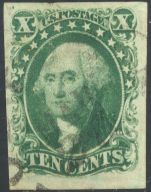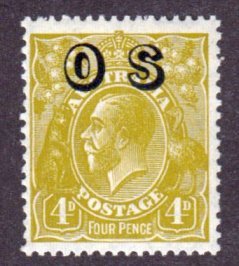
Discussion - Member to Member Sales - Research Center

Discussion - Member to Member Sales - Research Center

When looking at used stamps, how can you tell the difference between regular and self-adhesive stamps?

Login to Like
this post
Sometimes it's easy, sometimes it's hard. The catalogs will give you the differences, which mostly lie with the perforations and they way that they are cut. Perforations on regular paper are usually round holes punched through the paper oooooooo. On self-adhesives, the perforations are die cut, jagged and pointed vvvvvvvv. The "jagged" cut is called "serpentine". The perforation measurements are usually different between the two stamps (of the same design) as well.

1 Member
likes this post.
Login to Like.
If the adhesive is gone, you can't tell by looking at the stamp. Catalogues, however, normally indicate the type of gum used for each issue. If you can't remove a stamp from paper by soaking it in water, chances are good that the gum was self-adhesive, although I've come across stamps issued before the "Self-Adhesive Era" (which we shall now call "SAE") that were affixed with waterproof glue and could not be removed.
Bob

Login to Like
this post
Sure you can tell, but often you need a catalog to help distinguish between the two.
Here is the back side of two used stamps of the same design. The one on the left is a self-adhesive, the other a regular sheet stamp. On the sheet stamp, note the rounded perforations. On the self-adhesive stamp note the flat perforations resulting from the die cutting.

And here is the front of the stamps.


Login to Like
this post
Here is another example, this time using stamps from the United States. They are MNH, and it will be obvious which one is the self-adhesive stamp. However, if they were used, it would be more difficult to discern which was which. However, again, note the rounded perforations on the regular gummed stamp, and the pointed perfs of the self-adhesive.

Another thing to do is to put the stamps together. With serpentine perforations, self adhesive stamps will fit together like puzzle pieces with the images aligned to each other. Regular perforated stamps will not fit together in the same manner so that the images are aligned unless you put the perforations along side each other as in the coil pair.

1 Member
likes this post.
Login to Like.
Thanks everyone for your help. How about booklet stamp? How can you tell that one?

Login to Like
this post
The same way. Die cutting will leave jagged perforations with that "v", while regular sheet, coil,and booklet stamps will have round perfs as per the examples provided.

Login to Like
this post
I'm sure this is straight-forward but I can't find an answer...
When looking at used stamps, how can you tell the difference between regular and self-adhesive stamps?

Login to Like
this post
10:58:51pm
re: How can you tell?
Sometimes it's easy, sometimes it's hard. The catalogs will give you the differences, which mostly lie with the perforations and they way that they are cut. Perforations on regular paper are usually round holes punched through the paper oooooooo. On self-adhesives, the perforations are die cut, jagged and pointed vvvvvvvv. The "jagged" cut is called "serpentine". The perforation measurements are usually different between the two stamps (of the same design) as well.

1 Member
likes this post.
Login to Like.

re: How can you tell?
If the adhesive is gone, you can't tell by looking at the stamp. Catalogues, however, normally indicate the type of gum used for each issue. If you can't remove a stamp from paper by soaking it in water, chances are good that the gum was self-adhesive, although I've come across stamps issued before the "Self-Adhesive Era" (which we shall now call "SAE") that were affixed with waterproof glue and could not be removed.
Bob

Login to Like
this post
11:12:19pm
re: How can you tell?
Sure you can tell, but often you need a catalog to help distinguish between the two.
Here is the back side of two used stamps of the same design. The one on the left is a self-adhesive, the other a regular sheet stamp. On the sheet stamp, note the rounded perforations. On the self-adhesive stamp note the flat perforations resulting from the die cutting.

And here is the front of the stamps.


Login to Like
this post
11:21:21pm
re: How can you tell?
Here is another example, this time using stamps from the United States. They are MNH, and it will be obvious which one is the self-adhesive stamp. However, if they were used, it would be more difficult to discern which was which. However, again, note the rounded perforations on the regular gummed stamp, and the pointed perfs of the self-adhesive.

Another thing to do is to put the stamps together. With serpentine perforations, self adhesive stamps will fit together like puzzle pieces with the images aligned to each other. Regular perforated stamps will not fit together in the same manner so that the images are aligned unless you put the perforations along side each other as in the coil pair.

1 Member
likes this post.
Login to Like.
re: How can you tell?
Thanks everyone for your help. How about booklet stamp? How can you tell that one?

Login to Like
this post
05:52:38pm
re: How can you tell?
The same way. Die cutting will leave jagged perforations with that "v", while regular sheet, coil,and booklet stamps will have round perfs as per the examples provided.

Login to Like
this post

